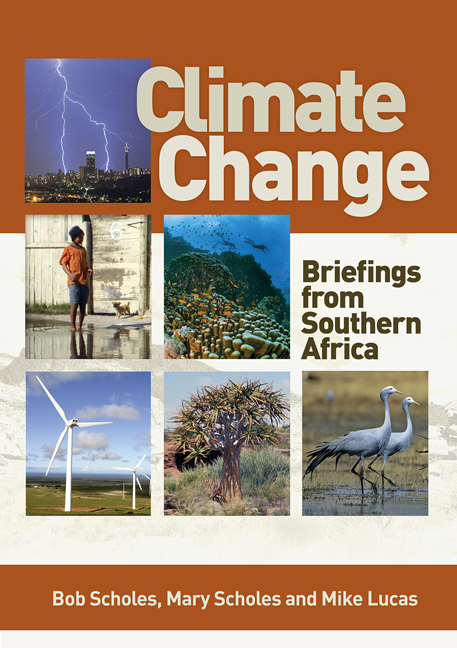Book contents
- Frontmatter
- Acknowledgements
- Contents
- Foreword
- Acronyms and abbreviations
- Preface
- How do governments assess climate change?
- Section 1 Earth system science: The processes that underlie climate change
- Section 2 Consequences of a changing climate for the Southern African environment
- Section 3 Consequences of a changing climate for society
- Introduction
- 1 Is the South African economy vulnerable to climate change?
- 2 How will climate change affect agriculture?
- 3 Will there be enough food to eat?
- 4 Do cow farts really cause global warming?
- 5 How will forestry in South Africa respond to climate change?
- 6 How will climate change affect South Africa's marine fisheries and aquaculture?
- 7 What are the human costs of climate change?
- 8 How do climate and air pollution interact to affect human health?
- 9 Will climate change cause malaria to spread in South Africa?
- 10 Should South Africans worry about rising sea levels?
- Section 4 What we can do to avoid and adapt to climate change
- Codicil Is there a dangerous level of climate change?
- Glossary
- List of figures
- References
- Reading list
- Index
8 - How do climate and air pollution interact to affect human health?
from Section 3 - Consequences of a changing climate for society
Published online by Cambridge University Press: 20 April 2018
- Frontmatter
- Acknowledgements
- Contents
- Foreword
- Acronyms and abbreviations
- Preface
- How do governments assess climate change?
- Section 1 Earth system science: The processes that underlie climate change
- Section 2 Consequences of a changing climate for the Southern African environment
- Section 3 Consequences of a changing climate for society
- Introduction
- 1 Is the South African economy vulnerable to climate change?
- 2 How will climate change affect agriculture?
- 3 Will there be enough food to eat?
- 4 Do cow farts really cause global warming?
- 5 How will forestry in South Africa respond to climate change?
- 6 How will climate change affect South Africa's marine fisheries and aquaculture?
- 7 What are the human costs of climate change?
- 8 How do climate and air pollution interact to affect human health?
- 9 Will climate change cause malaria to spread in South Africa?
- 10 Should South Africans worry about rising sea levels?
- Section 4 What we can do to avoid and adapt to climate change
- Codicil Is there a dangerous level of climate change?
- Glossary
- List of figures
- References
- Reading list
- Index
Summary
Some of the most dangerous pollutants are also greenhouse gases. Reducing air pollution has health benefits and also reduces climate change and vice versa.
Direct effects of climate change on human health include cardiovascular disease resulting from increasing heat stress, and the increased spread of some insect-transmitted and water-borne diseases. Changes in atmospheric composition, partly linked to climate change, alter the duration and intensity of ultraviolet (UV) radiation, increasing the risk of certain types of skin cancers, including dangerous melanomas. South Africa has high ultraviolet levels and incidences of skin cancer, partly because much of the country is above 1 000 m in altitude and the thinner atmosphere at those levels provides less protection.
Weather and climate play an important role in air quality. Reducing the emissions of long-lived greenhouse gases such as carbon dioxide (CO2) also generally leads to lower pollutant emissions of all sorts. The direct impact of low air quality on human health mostly involves respiratory allergies and diseases. Certain types of air pollution get worse under hotter, more humid conditions. Indirect but interactive effects of climate change and air pollution include increased human exposure to pollen (due to altered growing seasons), moulds (from extreme or more frequent precipitation), dust (from land laid bare by droughts) and smoke (from veld burning). On the positive side, action taken to reduce climate change by restricting emissions from vehicles and from fossil-fuel-burning power stations has the side benefit of reducing sulphur and nitrogen oxide emissions, which are harmful to humans and ecosystems.
Two of the biggest air quality problems in South Africa are the impacts of ozone (O3) and particulate matter (PM). Ozone near Earth's surface (tropospheric ozone, not to be confused with high-altitude stratospheric ozone which acts as an ultraviolet shield) is a powerful but short-lived greenhouse gas and an aggressive pollutant because it is highly reactive with other substances. It forms from the interaction of other pollutants, articularly nitrogen oxides and volatile organic compounds, in the presence of sunlight. Since tropospheric ozone does not last very long in the atmosphere, high concentrations of ozone tend to be quite local.
Tropospheric ozone usually coexists with other hazardous pollutants such as carbon monoxide, sulphur dioxide and PM of different sizes.
- Type
- Chapter
- Information
- Climate ChangeBriefings from Southern Africa, pp. 131 - 132Publisher: Wits University PressPrint publication year: 2015



